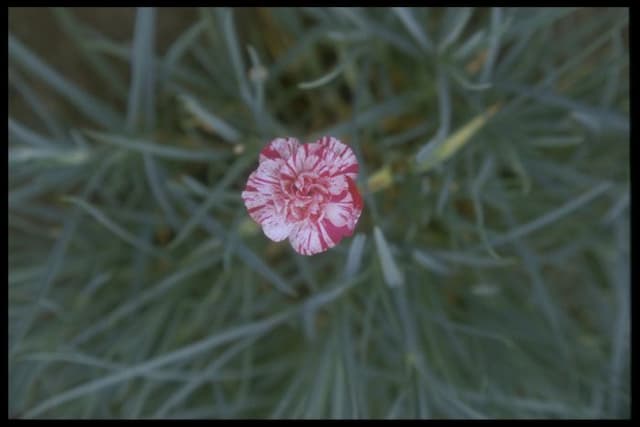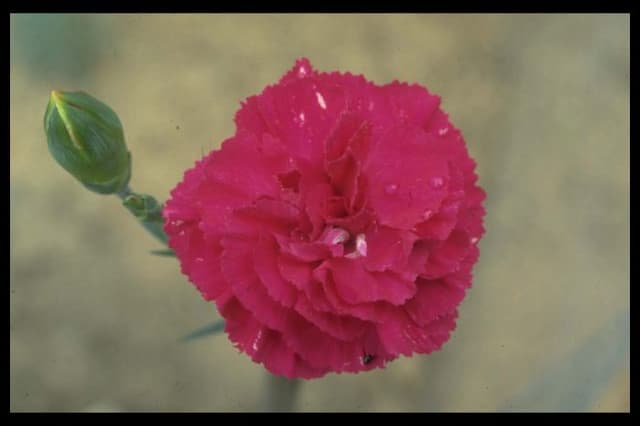Greater Stitchwort Stellaria holostea

ABOUT
Stellaria holostea, commonly known as Greater Stitchwort, is a flowering plant that displays a charming and delicate appearance. It features thin, slender stems that are green and sometimes tinged with red. The leaves of the Greater Stitchwort are narrow, lance-shaped, and smooth with pointed tips, giving the foliage a somewhat wiry and grass-like look. These leaves are arranged oppositely along the stems and have a fresh green hue that complements the flowers beautifully. The Greater Stitchwort is best known for its star-like flowers, which are pure white and have a distinctive display of five deeply cleft petals; this makes them appear to be ten petals rather than five. Each flower has a diameter that adds a prominent bright spot to the plant’s overall look. At the center of the flower, a cluster of yellowish-green stamens is visible, providing a lovely contrast to the white petals. These flowers bloom profusely in loose clusters, giving the plant a frothy appearance, especially when seen en masse. One of the striking features of the Greater Stitchwort is the way its flowers seem to twinkle and sparkle in the light, thanks to their reflective petals. This effervescent quality makes them particularly noticeable in their natural habitat. Less prominently, but still an integral part of the plant's appearance, are the small green seed capsules that develop after the flowers have been pollinated. These capsules hold the future seed of the Greater Stitchwort, ensuring its proliferation in suitable conditions. The overall aesthetic of the Greater Stitchwort is one of wild, untamed beauty, with a delicate structure that belies its resilience in the wild.
About this plant
 Names
NamesFamily
Caryophyllaceae.
Synonyms
Greater Stitchwort, Addersmeat, Star Chickweed, Starwort, Satin Flower, Dead Men's Bones, Easter Bell, Wedding Cakes, Daisy's Cousin.
Common names
Alsine holostea, Stellaria grandiflora, Holosteum alsine, Holosteum holosteum, Stellaria holostea var. grandiflora, Stellaria holostea var. holostea.
 Toxicity
ToxicityTo humans
Greater stitchwort, the common name for Stellaria holostea, is not widely recognized as a highly toxic plant for humans. However, like many plants, it may cause some mild gastrointestinal upset if ingested in large quantities. This can include symptoms like nausea, vomiting, and diarrhea. It is always recommended to exercise caution and not consume any part of plants unless they are confirmed to be safe for human consumption.
To pets
Greater stitchwort may also have similar mild toxic effects on pets if ingested. While not known to be severely toxic, pets may experience gastrointestinal upset, leading to symptoms such as nausea, vomiting, and diarrhea when they consume parts of the plant. As with humans, it is advisable to prevent pets from consuming plants that are not known to be safe.
 Characteristics
CharacteristicsLife cycle
Perennials
Foliage type
Deciduous
Color of leaves
Green
Flower color
White
Height
1 feet 2 inches (0.35 meters)
Spread
1 feet (0.30 meters)
Plant type
Herb
Hardiness zones
5
Native area
Europe
Benefits
 General Benefits
General Benefits- Wildlife habitat: Greater stitchwort provides shelter and breeding sites for a variety of insects, especially beneficial pollinators such as bees and butterflies.
- Ecosystem balance: Being a native species in many areas, it plays a role in the natural balance and biodiversity of local ecosystems.
- Aesthetic value: With its delicate white flowers, greater stitchwort adds beauty and natural charm to woodland areas and wildflower gardens.
- Erosion control: Like other groundcovers, greater stitchwort can help reduce soil erosion in certain environments.
- Edible parts: Some parts of the plant are edible (always with caution and proper identification) and are sometimes used in salads or as a cooked green.
 Medical Properties
Medical Properties- Anti-inflammatory: Stellaria holostea is traditionally used for its anti-inflammatory effects.
- Diuretic: It may have diuretic properties that could help with the removal of excess fluids in the body.
- Expectorant: The common starwort has been used to aid in expelling mucus from the respiratory tract.
- Demulcent: The plant has mucilaginous properties that could soothe irritated tissues.
- Astringent: It may help in tightening and toning the skin or mucous membranes, thus reducing secretions or bleeding from minor abrasions.
 Air-purifying Qualities
Air-purifying QualitiesThis plant is not specifically known for air purifying qualities.
 Other Uses
Other Uses- Indicator of soil fertility: Greater Stitchwort often grows in places where the soil is rich in nutrients, particularly calcium, hence can be a natural indicator of soil condition.
- Floral arrangements: Fresh or dried, the delicate white flowers of Greater Stitchwort can be used to add an ethereal quality to floral arrangements and bouquets.
- Photography subject: The star-shaped flowers of the Greater Stitchwort make it a lovely subject for photographers, particularly in woodland settings.
- Biological study: Greater Stitchwort can be used in ecological studies to understand the distribution and health of woodland understorey plant communities.
- Fairy lore: In folklore, it is said that fairies are fond of Stitchwort, making it a playful addition to fairy gardens and mythological plant collections.
- Educational tool: With its clear dicot structure, Greater Stitchwort can be used to educate students on plant biology and identification.
- Garden groundcover: When allowed to spread, Greater Stitchwort can provide a natural groundcover in garden areas that receive partial shade.
- Livestock grazing indicator: The presence of Greater Stitchwort in a pasture may indicate levels of grazing pressure, as it thrives in less grazed areas.
- Crafting: The stems and flowers can be used in the craft of plant pressing, preserving the beauty of the plant in a traditional manner.
- Bird habitat: Greater Stitchwort provides cover for ground-nesting birds and small mammals in its natural habitat.
Interesting Facts
 Feng Shui
Feng ShuiGreater Stitchwort is not used in Feng Shui practice.
 Zodiac Sign Compitability
Zodiac Sign CompitabilityGreater Stitchwort is not used in astrology practice.
 Plant Symbolism
Plant Symbolism- Innocence: The Stellaria holostea, commonly known as Greater Stitchwort, often symbolizes innocence due to its delicate and small white flowers, reminiscent of the purity and simplicity found in nature.
- Fragility of Life: The slender stems and fragile appearance of the Greater Stitchwort may represent the delicate balance and ephemeral nature of life.
- Protection: Historically, the Greater Stitchwort has been used in folk medicine; this practice led to an association with protection from harm and illness.
- Unity: The five-petaled flowers of the Greater Stitchwort are frequently observed as a symbol of unity and connectedness, illustrating the idea that strength can be found in coming together.
 Water
WaterGreater Stitchwort requires moderate watering, aiming to keep the soil consistently moist but not waterlogged. During the growing season, water the plant with about 1 inch of water per week. Adjust the frequency to account for rainfall; less water may be needed during rainy periods and more water during dry spells. It's best to water this plant in the morning to allow the foliage to dry out during the day, reducing the risk of fungal diseases. Always check the top inch of soil before watering; if it feels dry to the touch, it's time to water.
 Light
LightGreater Stitchwort thrives best in full sunlight to partial shade. Ideal locations for this plant are spots where it can receive at least 4-6 hours of direct sunlight daily, although it can tolerate some shade, especially in the heat of the afternoon. When grown in too much shade, the plant may become leggy and produce fewer flowers.
 Temperature
TemperatureGreater Stitchwort prefers a temperate climate and can tolerate a range of temperatures. It can survive minimum temperatures down to about 20 degrees Fahrenheit, but grows best in temperatures between 60 and 75 degrees Fahrenheit. While it can endure short periods of colder or warmer weather, prolonged exposure to extremes outside of its tolerance range can be detrimental.
 Pruning
PruningPruning Greater Stitchwort is important to maintain its shape, encourage bushier growth, and remove spent blooms which can encourage a second flush of flowers. Pruning should be done in early spring before new growth starts or straight after its flowering period ends. Cut back the plant by about one-third to promote fresh growth and a compact shape.
 Cleaning
CleaningAs needed
 Soil
SoilGreater Stitchwort thrives in well-drained soil with high organic content and prefers a pH range of 6.0 to 7.5. A balanced mix could be comprised of garden soil, compost, and leaf mold to support its growth.
 Repotting
RepottingGreater Stitchwort typically does not require frequent repotting and can be repotted every two to three years or when it outgrows its current container.
 Humidity & Misting
Humidity & MistingGreater Stitchwort prefers moderate humidity levels but is quite adaptable to various conditions as long as it is not overly dry for extended periods.
 Suitable locations
Suitable locationsIndoor
Ensure bright light, cool temps, and moist soil for indoor Greater Stitchwort.
Outdoor
Plant in partial shade, moist soil, and protect from harsh sun for outdoor Greater Stitchwort.
Hardiness zone
4-8 USDA
 Life cycle
Life cycleThe life of Stellaria holostea, commonly known as Greater Stitchwort, begins with seed germination, which occurs in spring when the soil temperature and moisture levels are adequate. The seeds develop into seedlings that establish a rosette of leaves at ground level. As the plant matures, it develops elongating stems that can grow up to 50 cm tall, adorned with pairs of narrow, lanceolate leaves. Greater Stitchwort flowers from April to June, displaying white, star-shaped flowers with five deeply divided petals, which are pollinated by insects. After pollination, the plant forms seed capsules that release seeds when mature, ensuring the continuation of the species. In winter, the above-ground parts of the plant die back, while the root system remains dormant until the next spring, completing its perennial cycle.
 Propogation
PropogationPropogation time
Spring-Early Summer
Propogation: Greater Stitchwort (Stellaria holostea) is commonly propagated through seed sowing. The optimal time for sowing the seeds is during the fall, as this allows for natural stratification during the winter months. For propagation, seeds should be scattered over the surface of a well-draining seed starting mix and lightly pressed into the soil. They require light to germinate, so they should not be covered with soil but may be gently pressed to ensure good contact. Keep the soil moist but not waterlogged, and place the container in a spot with indirect light at a temperature of about 65 to 70 degrees Fahrenheit (18 to 21 degrees Celsius). Germination usually occurs within two to three weeks. Once seedlings have grown strong enough, they can be transplanted outdoors in the spring after the danger of frost has passed.






![Pink [Coconut Sundae]](/_next/image?url=https%3A%2F%2Fplants-admin.emdemapps.com%2Fimages%2Fplants%2F%2Fimages%2F604b5d09d4fd1.png&w=640&q=75)


